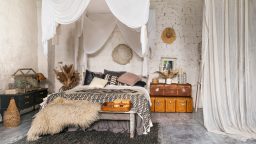The dining area is one of the most important spaces in a home. It’s where you gather with family and friends to share meals, celebrate special occasions, and create lasting memories. Whether you have a spacious dining room or a compact nook, creating a stylish and functional dining area is key to enhancing your home’s aesthetic while ensuring comfort and practicality. Here’s how you can strike the perfect balance between style and functionality in your dining space.
- Choose the Right Dining Table
The dining table is the focal point of the room, so it’s essential to choose one that suits both your style and the size of your space. When selecting a dining table, consider the following:
- Size: The table should be appropriately sized for your room. A large table may overwhelm a small space, while a tiny table may feel cramped in a large room. As a general rule, there should be at least 90 cm of space around the table to allow for easy movement and seating.
- Shape: Dining tables come in various shapes, such as rectangular, square, round, and oval. Rectangular tables are ideal for larger spaces, while round and oval tables are perfect for smaller rooms, creating a softer, more intimate atmosphere. Round tables are also great for fostering conversation, as there’s no ‘head’ of the table.
- Material: The material of the table influences the overall vibe of the dining area. Wooden tables add warmth and a rustic charm, while glass tables create an airy, modern feel. For a more industrial look, metal tables are an excellent choice, while marble tables offer a touch of luxury and sophistication.
- Consider the Seating
Comfortable seating is a must in a dining area, especially if you enjoy hosting dinner parties or family meals. The style and material of the chairs should complement your table, but they should also provide ample support for long meals. Consider the following:
- Chairs: Classic wooden dining chairs work well in many settings, while upholstered chairs offer extra comfort and luxury. If you prefer a more eclectic look, mix and match different chair styles or materials for a unique, personalised touch.
- Bench Seating: For a more casual or family-friendly dining area, consider using a bench instead of chairs. Bench seating can be a great way to accommodate more people and can add a relaxed, contemporary vibe to the room.
- Cushions and Throws: To make seating even more comfortable, especially for long meals, add cushions or throws to your chairs or benches. Not only do they add extra comfort, but they also provide an opportunity to introduce colour, texture, or patterns into the space.
- Maximise Storage and Functionality
A dining area isn’t just about the table and chairs—it’s also about functionality and storage. Consider incorporating practical storage solutions that make your dining area both stylish and efficient.
- Sideboards and Buffets: These pieces of furniture are perfect for storing tableware, napkins, glassware, and serving dishes. A stylish sideboard can also double as a decorative piece in the room. Opt for a design that complements your table and overall aesthetic.
- Shelving: If you’re short on storage, wall-mounted shelves can be a great solution. You can display decorative pieces, such as candles or plants, while keeping everyday items neatly organised.
- Storage Benches: A storage bench placed against a wall or under a window is both practical and space-efficient. Use it to store extra chairs, cushions, or other dining-related items that you don’t use regularly.
- Lighting is Key
Good lighting sets the mood in your dining area and ensures that the space feels inviting and functional. Layering different types of lighting can help create the right atmosphere for every occasion.
- Pendant Lights: A statement pendant light or chandelier above the dining table can add a touch of elegance and style. Choose a fixture that’s in proportion to your table’s size and complements the room’s overall aesthetic. A dimmer switch is a great addition, allowing you to adjust the lighting for different times of day or occasions.
- Ambient Lighting: In addition to a central light fixture, consider adding ambient lighting to your dining area. Table lamps, wall sconces, or floor lamps can create a warm and welcoming atmosphere. Soft, low lighting helps encourage relaxed dining experiences.
- Task Lighting: If you do a lot of work in your dining area, such as prepping meals or writing notes, ensure that you have adequate task lighting. Under-cabinet lighting or a small desk lamp can provide additional light where you need it most.
- Add Personality with Accessories
Once you’ve chosen your furniture and lighting, it’s time to add the finishing touches. Accessories are a great way to inject personality and style into your dining area without overwhelming the space.
- Tableware and Linens: A well-set table can make all the difference in creating a stylish dining area. Invest in quality tableware that suits your style—whether it’s minimalist white dishes, colourful ceramics, or elegant china. Add table runners, placemats, and cloth napkins for an extra touch of sophistication.
- Artwork and Mirrors: Hang artwork or a statement mirror on the walls to elevate the overall design. Art can help personalise the space and give it a unique flair. Mirrors, especially in smaller rooms, can create a sense of openness and reflect light to brighten the space.
- Plants and Greenery: Incorporating plants into your dining area brings life to the space and enhances the natural vibe. Choose plants that thrive in indoor environments, such as peace lilies or ferns, and place them on a windowsill or side table.
- Decorative Items: Consider adding decorative pieces like vases, candles, and bowls to your dining area. These items can add colour, texture, and interest to the space, without cluttering it.
- Pay Attention to the Layout
The layout of your dining area is crucial to its functionality. Ensure there’s enough space for people to move around comfortably, especially when they need to pull out chairs or walk to the kitchen. Allow at least 90 cm between the table and any walls or furniture, giving guests enough room to sit and stand.
If you have a separate dining room, position the table centrally in the room, leaving space on all sides for ease of movement. In an open-plan space, be mindful of the layout so that the dining area feels distinct but still connected to the rest of the room.
- Keep it Flexible
While you want your dining area to look stylish, it’s equally important that it functions well for a variety of situations. Choose furniture that can be easily rearranged for different occasions. A table that extends, stackable chairs, or movable benches offer flexibility for both intimate dinners and large gatherings.
Conclusion
Creating a stylish and functional dining area involves a balance of aesthetics and practicality. From choosing the right table and seating to adding the perfect lighting and accessories, every element plays a role in shaping the space. By considering your space’s layout, your storage needs, and your personal style, you can craft a dining area that is both beautiful and functional—perfect for family meals, entertaining guests, or enjoying a quiet dinner alone.





